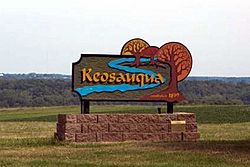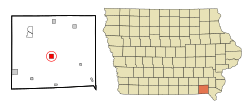Keosauqua, Iowa facts for kids
Quick facts for kids
Keosauqua, Iowa
|
|
|---|---|
|
City
|
|

Keosauqua welcome sign
|
|

Location of Keosauqua, Iowa
|
|
| Country | |
| State | |
| County | Van Buren |
| Area | |
| • Total | 1.58 sq mi (4.10 km2) |
| • Land | 1.46 sq mi (3.78 km2) |
| • Water | 0.12 sq mi (0.32 km2) |
| Elevation | 633 ft (193 m) |
| Population
(2020)
|
|
| • Total | 936 |
| • Density | 641.54/sq mi (247.74/km2) |
| Time zone | UTC-6 (Central (CST)) |
| • Summer (DST) | UTC-5 (CDT) |
| ZIP code |
52565
|
| Area code(s) | 319 |
| FIPS code | 19-40935 |
| GNIS feature ID | 2395517 |
Keosauqua (/ˌkiːəˈ[unsupported input]kwə/ KEE-ə-SAW-kwə) is a city in Van Buren County, Iowa, United States. It is the county seat, meaning it is the main town where the county government is located. In 2020, the population of Keosauqua was 936 people.
Contents
History of Keosauqua

Keosauqua was first planned out in 1839. Its name comes from the Meskwaki and Sauk Native American tribes. They called the Des Moines River "Ke-o-saw-qua," which means "Bend in the River." This name describes how the river curves around the city.
Historic Buildings and Landmarks
One of Keosauqua's most famous buildings is the Hotel Manning. It is a three-story hotel that reminds people of the steamboat days on the Des Moines River. Its special "Steamboat Gothic" style looks like the riverboats from the mid-1800s. The hotel was added to the National Register of Historic Places in 1973. In 2017, a group of community members bought the hotel. They worked hard to repair and improve it, bringing it back to its original beauty. Today, the Hotel Manning is still an important part of the history and culture of southeastern Iowa.
Keosauqua also has other important historic places:
- The Pearson House was built in 1847. It was a secret stop on the Underground Railroad, a network that helped enslaved people find freedom.
- The Van Buren County Courthouse was built in 1843. It is designed in the Greek Revival style. This courthouse is the oldest one in Iowa that has been used continuously. It is also the second-oldest in the entire United States. It is also listed on the National Register of Historic Places. A famous legal case, the trial of William McCauley, took place here. This event was the first legal outcome of its kind in Iowa's history.
Important Events and People
In 1846, Brigham Young and his followers, known as the Mormons, were forced to leave their home in Nauvoo, Illinois. Their journey led them across the Des Moines River near Keosauqua. This crossing point is now part of what is known as the Mormon Trail.
A local hero from Van Buren County was Voltaire Twombly. He received the Congressional Medal of Honor for his brave actions during the American Civil War. After the war, he served as the mayor of Keosauqua. He was also a businessman and built a stone building on the main street that is still there today.
The Honey War happened south of Keosauqua in 1839. It got its name because three trees with beehives were cut down during the dispute. This event was a disagreement about the border between Iowa and Missouri. Militias from both sides gathered, but luckily, the problem was solved without any fighting.
Lacey-Keosauqua State Park
Lacey-Keosauqua State Park is one of the biggest state parks in Iowa. It was built by the Civil Conservation Corps during the Great Depression. The stone work on the lake bathhouse and lodge, made from stone found within the park, shows the amazing work they did.
Keosauqua celebrates its annual Fall Festival during the second full weekend of October.
Geography and Nature
Keosauqua is located in an area called the Southern Iowa Drift Plain. This land was shaped by ancient glaciers about 300,000 years ago. The area has many rolling hills covered with forests, mixed with farmland. Many small streams flow into the Des Moines River. In the 1800s, the Des Moines River was wide enough for steamboats, which is why Keosauqua was founded here.
The city covers about 1.57 square miles (4.10 square kilometers). Most of this area is land, with a small part being water.
Population and Demographics
| Historical populations | ||
|---|---|---|
| Year | Pop. | ±% |
| 1850 | 705 | — |
| 1870 | 869 | +23.3% |
| 1880 | 883 | +1.6% |
| 1890 | 831 | −5.9% |
| 1900 | 1,117 | +34.4% |
| 1910 | 1,009 | −9.7% |
| 1920 | 851 | −15.7% |
| 1930 | 855 | +0.5% |
| 1940 | 1,040 | +21.6% |
| 1950 | 1,101 | +5.9% |
| 1960 | 1,023 | −7.1% |
| 1970 | 1,018 | −0.5% |
| 1980 | 1,003 | −1.5% |
| 1990 | 1,020 | +1.7% |
| 2000 | 1,066 | +4.5% |
| 2010 | 1,006 | −5.6% |
| 2020 | 936 | −7.0% |
| Source: and Iowa Data Center Source: |
||
2020 Census Information
According to the census from 2020, Keosauqua had 936 people living in 429 households. The population density was about 641.6 people per square mile (247.7 people per square kilometer).
Most of the people living in Keosauqua were White (95.3%). There were also small percentages of Black or African American, Native American, Asian, and people from two or more races. About 2.2% of the population was Hispanic or Latino.
The average age of people in Keosauqua was 54.3 years. About 19.6% of residents were under 20 years old, and 34.2% were 65 years or older. Slightly more than half of the population (53.1%) was female, and 46.9% was male.
Education
The schools in Keosauqua are part of the Van Buren County Community School District. Before July 1, 2019, the community was served by the Van Buren Community School District.
Keosauqua is home to the Van Buren Warriors at Van Buren High School. Harmony High School joined with Van Buren High School at the end of the 2015–2016 school year. In 2018, the Van Buren district voted to merge with the Harmony Community School District.
Notable People from Keosauqua
Many interesting people have connections to Keosauqua:
- Josiah H. Bonney (1817–1887), a politician who served as Iowa Secretary of State.
- Smith W. Brookhart (1869–1944), a US Senator from Iowa.
- Henry Clay Caldwell (1832–1915), a United States federal judge and an officer in the Union Army.
- Caroline Matilda Dodson (1845–1898), a physician.
- Sallie Fox (1845–1913), a California pioneer who grew up in Keosauqua.
- James B. Howell (1816–1880), a newspaper editor and U.S. Senator, who lived in Keosauqua.
- Leonard John Rose (1827–1899), a California pioneer and leader of the Rose–Baley Party, who lived in Keosauqua from 1848 to 1858.
- Theodosia Burr Shepherd (1845–1906), a botanist who studied plants.
- Phil Stong (1899–1957), an American author and journalist. He is famous for writing the novel State Fair, which was made into three movies.
- Voltaire P. Twombly (1842–1918), an Iowan politician and businessman. He received the Medal of Honor during the American Civil War and is buried in Keosauqua.
- Edward K. Valentine (1843–1916), a US Representative from Nebraska.
- George G. Wright (1820–1896), a US Senator from Iowa.
Gallery
-
Franklin Pearson House, listed on the National Register of Historic Places
See also
 In Spanish: Keosauqua (Iowa) para niños
In Spanish: Keosauqua (Iowa) para niños





